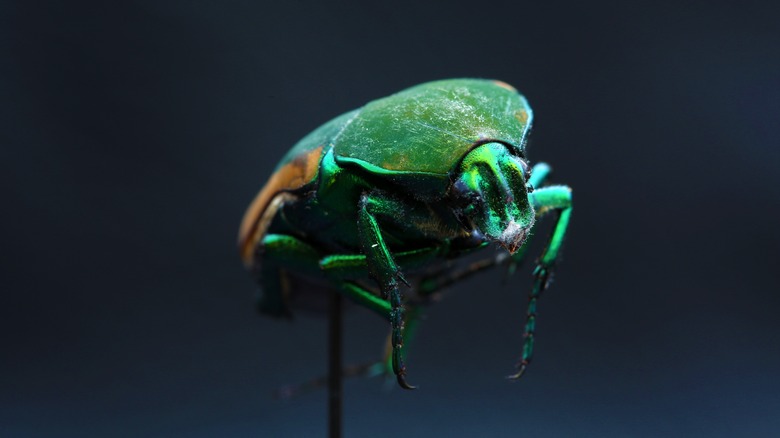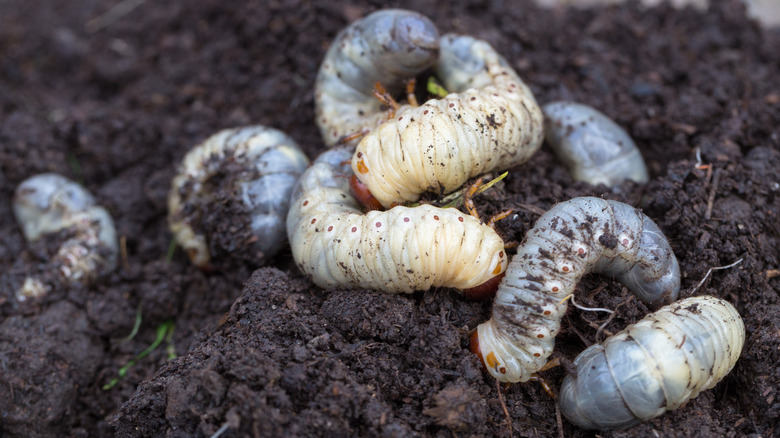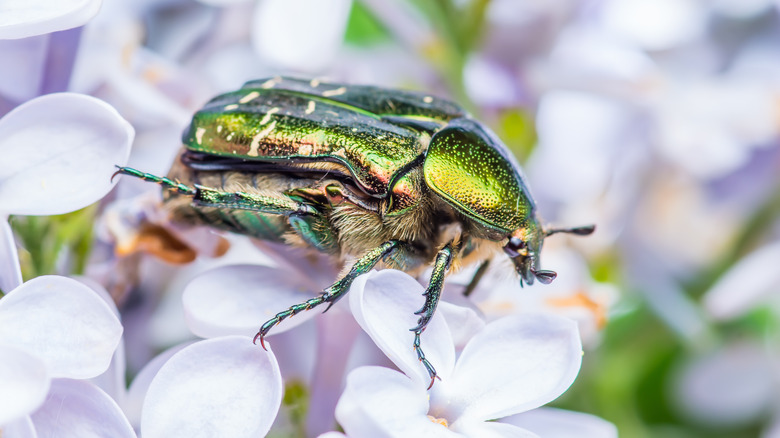How To Really Get Rid Of June Bugs
How do you really get rid of June bugs? The answer, according to the old joke, is to wait until July. There are actually several tried and true ways to combat this member of the scarab family, which sticks around well past June until the end of the summer.
June bugs were introduced to the U.S. in 1915 on a Minnesota pig farm, and have since attained invasive status, according to How To Get Rid Of All Things. Many of the world's beetles belong to scarab species, including 6 of the most familiar ones: Common June Bug; Ten-lined Beetle; Green Fruit Beetle; Green June Bug; Japanese Beetle; and European Chafer. They are found everywhere except Antarctica, and they are fixtures of North American late springs and early-to-mid summers. Per the Entomology Extension at Texas A&M, the mature insects are oval, ½ to ⅝ inches long, and shiny. The larvae are whitish, up to 2 inches in length, and characteristically curled.
Sod Solutions asserts that June bug larvae can cause more damage than adults to the extent they could conceivably decimate an entire lawn if left to their own devices. Treating lawns is an essential strategy to eliminate these grubs. There is also a wide range of options to repel or exterminate June bug babies and adults before your leaves, trees, and roses fall victim to these voracious pests.
Getting rid of June bug larvae
In mid-summer, female beetles lay eggs in areas with short grass and access to soil, where the resulting larvae thrive before hatching into adults. Cedarcide strongly suggests nipping a potential infestation in the bud by making one's lawn inhospitable. Allow the grass to grow at least 3 inches long before mowing and water it frequently. If you do manicure the lawn, bag up the grass clippings. Remove fallen fruit and harvest any viable vegetables or fruit (June bugs like them too).
Lawns can be treated with chemical insecticides, but there are more environmentally friendly ways to control these insects. Eartheasy recommends a single application of the milky spore bacterium (Bacillus popilliae) to attack Japanese beetles at the larval stage. The grubs are infected with it, die, and decay, injecting more spores into the soil.
To apply milky spore, spread a teaspoon of powder at 4-foot intervals, then water gently for a few minutes. This method can provide up to 10 years of pest control because the bacteria will naturally reproduce themselves billions of times over. Birds + Wild notes that Bacillus thuringiensis (Bt) is another commercially sold deterrent that works against June bugs. However, it can be harmful to caterpillars and thus impact butterflies. Available online, nematodes are worms that can be introduced to the soil to get rid of the larvae. Nematodes are best applied in the spring and fall. Neem oil can destroy June bug grubs, but may be toxic to bees.
Getting rid of June bug adults
June bugs can be captured using commercial or DIY traps, which are most effective against large swarms. However, successful eradication might require a large amount of traps. Store-bought options need to be replaced frequently, and home-made traps require regular corpse removal and ingredient replenishment. DIY traps can be fashioned from milk or juice cartons. Cut off the top and bury the bottom, leaving the opening accessible. Arm it with a sticky substance such as vegetable oil or molasses as bait. Then, much like prey falling into the pitcher of a ruthless carnivorous plant, the victim will enter the trap but be unable to escape. June bugs are weak flyers. Catching them by hand, then dropping them into a carton or jar filled with soapy water, will end their lives.
Plants can be used against June bugs. Tomatoes are effective repellents. Odiferous plants such as rosemary, lavender, mint, or citronella might also keep them at bay. Diatomaceous earth derived from algae is a June bug slayer. Its powdery, sharp-edged texture can fatally wound them. The insects are drawn to light; minimizing outdoor light is an effective deterrent. Ask An Entomologist points out that they don't see well within the yellow/red spectrum, so use yellow bulbs outside. Encouraging your neighbors to battle their bugs is another strategy. June bugs are devoured by about 30 different insect species, according to Dalhousie University. Attracting those good guys is yet another way to get rid of the bad guys.


